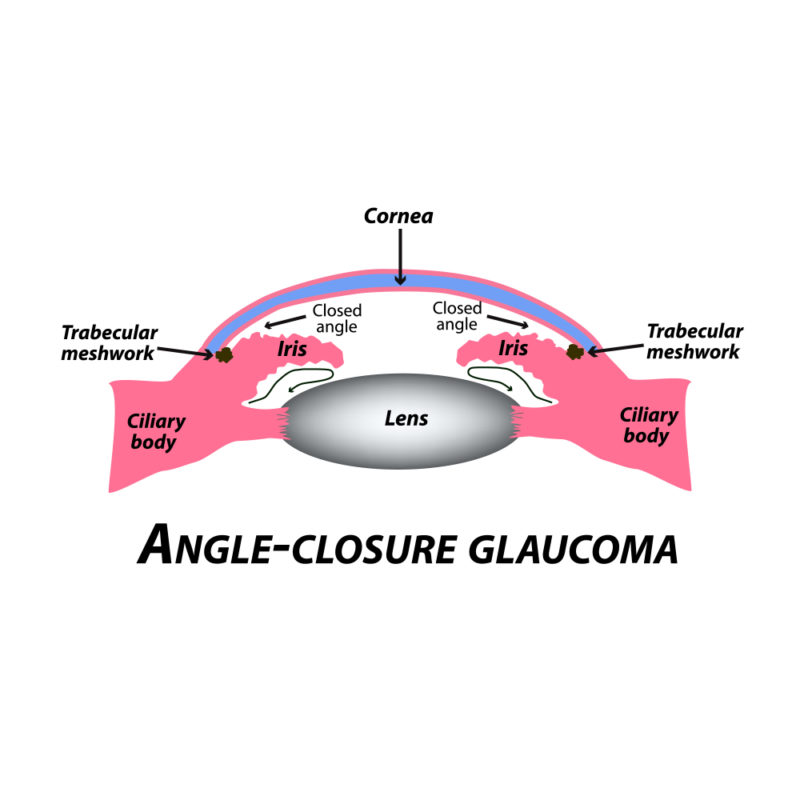There are several types of glaucoma. The two main types of glaucoma are open-angle and narrow angle glaucoma.
Open-angle glaucoma is the most common type of glaucoma and accounts for at least 90% of all glaucoma cases, affecting about three million Americans. It is called open-angle because the angle where the iris meets the cornea is as wide as it should be, allowing fluid access to the drain.
Narrow-angle glaucoma is also known as acute glaucoma or closed angle glaucoma. It is rarer than open-angle glaucoma. It is caused by blocked drainage canals, resulting in a sudden rise in intraocular pressure. It develops very quickly, which demands immediate medical attention. Angle -closure may occur in an acute or chronic form.
What essentially happens is, fluid is continually produced inside and drains out of the normal eye. This fluid is known as aqueous humor and is unrelated to tears. When there is an imbalance in the production and drainage of fluid in the eye, the pressure in the eye becomes high. If the channels within the eye that drain this fluid from the inside of the eye do not function properly or are blocked, the pressure will rise. When this happens, more fluid continues to be produced but cannot be drained because of the blocked or improperly functioning drainage channels, resulting in an increased amount of fluid inside the eye’s limited space raising the intraocular pressure.
Angle-closure glaucoma, also called acute glaucoma or narrow-angle glaucoma is a result of the angle between the iris and cornea closing or not being as open as it should be. When this happens, the pupil and the iris bunches up over the drainage canals.
Signs and Symptoms of Acute Angle-Closure Glaucoma:
- Headaches
- Nausea, vomiting
- Halos around lights
- Blurred vision
- Painful red eye
- Aching eye or brow pain
- Corneal edema
- Dilated pupil
- Engorged conjunctival vessels
- Extremely elevated intraocular pressure
- Closed angle on gonioscopy
Other key factors include the presence of hyperopia and thick cataractous lens.
Health Conditions that may cause angle-closure glaucoma:
- Ectopic Lens
- Cataracts
- Diabetic Retinopathy
- Ocular Ischemia
- Uveitis
- Tumors
People with farsightedness (hyperopia) are at an increased risk for acute angle-closure glaucoma because the anterior chambers are shallower, their eyes are smaller, and their angles are narrower.
Diagnosis of Acute Angle-Closure Glaucoma
- Ophthalmoscopy – your doctor may examine the optic nerve looking for damage.
- Tonometry – numbing drops are put into your eye, and then your doctor holds a pencil-shaped device against the outside of your eyeball to measure the intraocular pressure.
- Gonioscopy – performed with the head positioned in a slit lamp, after numbing the eye with drops. A
special contact lens is placed directly on the eye and a beam of light is used to illuminate the angle.
Treatment of angle-closure glaucoma
The first thing your doctor may do to treat an acute angle-closure attack is use drops to lower the pressure in your eyes, and medication to lower the amount of fluid your eye produces. Treatment of angle-closure glaucoma usually involves laser surgery to remove a small portion of the bunched-up outer edge of the iris. Surgery helps to unblock the drainage canals so that the extra fluid may drain.
If you are being treated for angle-closure glaucoma in one eye, your doctor may go ahead and treat your other eye as a safety measure – surgery is usually successful and long-lasting.







